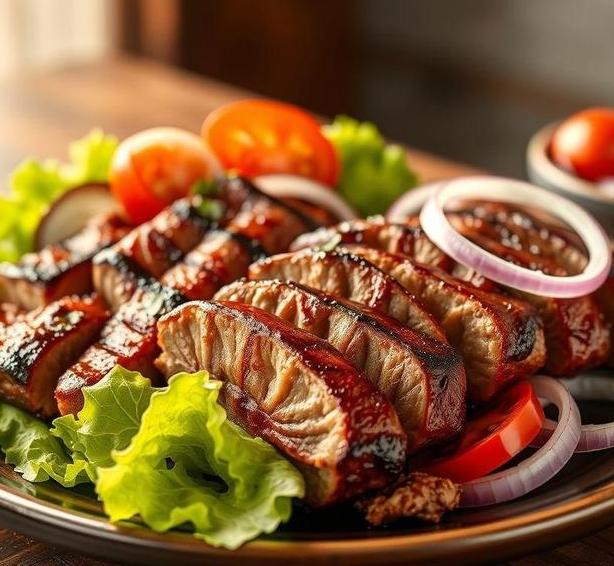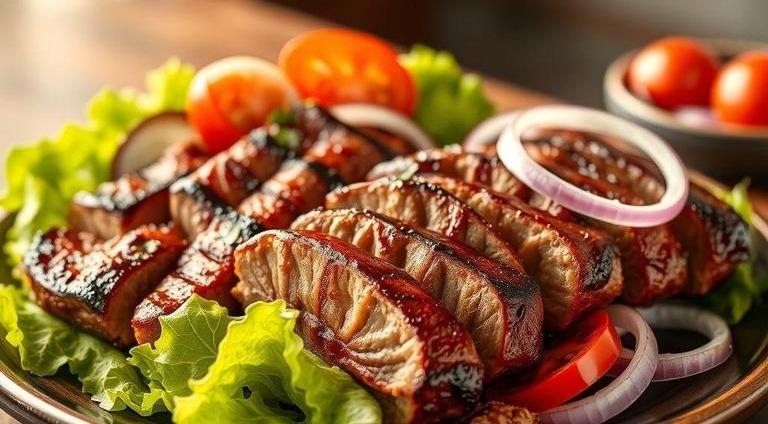Gyro meat is a savory delight loved by many, whether it’s stacked on a warm pita, served with crispy fries, or piled high on a platter. This classic Greek dish, traditionally made from lamb, beef, or chicken, is known for its rich, spiced flavor and tender texture. But if you’ve ever wondered about how long that delicious meat can last or if it can go bad, you’re not alone. Storing gyro meat properly and knowing the signs of spoilage are essential to ensure that every bite is as fresh and safe as it was when it was first cooked.
In this guide, we’ll dive into the details of gyro meat’s shelf life, how to store it, and the red flags you should look out for that signal when it’s time to toss it out. If you’ve got leftovers or are wondering how to store that leftover gyro meat from your favorite restaurant, you’ll want to read on.
Can Gyro Meat Go Bad?
Yes, just like any meat, gyro meat can absolutely go bad. Even though it’s cooked, it still contains perishable ingredients that are susceptible to spoilage over time. The meat, seasoning, and any sauces used can break down or ferment, resulting in an unpleasant smell, taste, or texture.
Factors that contribute to gyro meat going bad include:
- Temperature: If left out at room temperature for too long, the meat can become a breeding ground for bacteria.
- Exposure to air: Oxygen can lead to oxidation, which speeds up the spoilage process.
- Improper storage: Not sealing or refrigerating the gyro meat properly can cause it to spoil faster.
So, while it’s perfectly fine to have leftover gyro meat in the fridge or freezer, if it’s not stored right, you’re risking its freshness, flavor, and safety.
Shelf Life For Gyro Meat

Understanding how long gyro meat lasts is key to maintaining quality and preventing foodborne illness. Its shelf life can vary based on storage methods, but here’s a general breakdown:
-
In The Fridge (cooked Gyro Meat)
If stored properly in an airtight container or wrapped tightly in plastic wrap, gyro meat will stay fresh for 3 to 4 days. It’s always best to eat it as soon as possible after cooking to retain the best taste and texture.
-
In The Freezer (cooked Gyro Meat)
Freezing can extend the shelf life significantly. When stored in a freezer-safe bag or container, cooked gyro meat can last for 2 to 3 months. However, it’s important to note that while the meat won’t go bad immediately after this time, its quality may begin to degrade. Freezing can affect its moisture content and texture, making it a little drier or tougher when reheated.
-
Uncooked Gyro Meat (fresh, Raw Meat)
If you’re working with raw gyro meat (such as fresh lamb, beef, or chicken), it has a much shorter shelf life. In the fridge, raw meat should be used within 1 to 2 days. Freezing it will extend its life to 3 to 4 months.
Common Signs Of Spoilage
Even if you’ve been careful about storing your gyro meat, it’s always smart to double-check for signs of spoilage. Here are the most common indicators that your gyro meat has gone bad:
-
Off Smell
If you notice any sour, rancid, or unpleasant odor coming from the meat, it’s a clear sign that it has spoiled. Fresh gyro meat, even after being stored, should have a savory, meaty scent. Any kind of foul odor means bacteria has likely started to grow.
-
Change In Texture
Spoiled gyro meat may feel slimy or sticky. Fresh cooked gyro meat should have a firm, moist texture. If it’s become excessively dry or mushy, discard it.
-
Discoloration
Gyro meat should maintain a deep brown, tan, or golden color depending on the type of meat used. If you notice any grey, green, or otherwise unnatural colors, it’s a sign of spoilage. Sometimes, freezer burn (which occurs when frozen meat is exposed to air) can lead to discoloration, but this doesn’t necessarily make it unsafe to eat, though it may affect taste and texture.
-
Mold
This is a definite red flag. Mold growth on the surface of the meat, especially if it’s been stored too long, indicates that it’s time to throw it out. Even a small amount of mold can cause the entire batch to be unsafe.
How To Store Gyro Meat?

Proper storage is the best way to ensure your gyro meat stays fresh for as long as possible. Here are some foolproof methods for keeping it safe:
-
Refrigeration
After you’ve enjoyed your gyro meal, place any leftover meat into an airtight container. If you don’t have one, wrap it tightly in plastic wrap or aluminum foil. Then, store it in the coldest part of the fridge (usually the back). Always aim to refrigerate the meat within 2 hours of cooking to prevent bacteria growth.
-
Freezing
If you have leftover gyro meat that you won’t be able to eat within a few days, freezing is the best option. For long-term storage, use freezer-safe bags or containers to minimize air exposure. Label the bags with the date to track how long it’s been frozen.
-
Vacuum Sealing
If you have a vacuum sealer, this is an excellent way to keep your gyro meat fresh for much longer. By removing air, vacuum sealing can prevent freezer burn and extend the shelf life of frozen gyro meat for up to 6 months or even longer.
-
Avoid The ’hot Zone’
Never leave cooked gyro meat out at room temperature for more than 2 hours. If it’s been sitting out longer than that, it’s best to toss it. The "danger zone" (temperatures between 40°F and 140°F) is where bacteria grow rapidly, so keep the meat out of it whenever possible.
Expert Tips
-
Reheat Carefully
When reheating leftover gyro meat, make sure it’s heated through to at least 165°F (74°C) to kill any harmful bacteria. Reheating on the stove or in the oven rather than the microwave tends to preserve the texture better, especially for meat that has been frozen.
-
Use It Quickly After Thawing
If you’ve frozen your gyro meat, it’s essential to defrost it in the fridge, not on the countertop. Once thawed, it should be consumed within 1 to 2 days, so plan your meals accordingly.
-
Make Sure It’s Airtight
For both refrigeration and freezing, always ensure that your gyro meat is sealed in an airtight environment. Exposure to air increases the chances of spoilage and freezer burn.
-
Add Freshness With A Little Heat
If your leftover gyro meat feels a bit dry after storing it, you can add a bit of olive oil, broth, or sauce when reheating it to restore some moisture and flavor.
FAQs
How Long Does Gyro Meat Last In The Fridge?
Gyro meat can last up to 3-4 days in the fridge if stored properly in an airtight container or tightly wrapped. After this period, it should be discarded to avoid the risk of foodborne illness.
Can You Freeze Gyro Meat?
Yes, gyro meat can be frozen for up to 2-3 months. To maintain the best quality, it should be wrapped tightly in plastic wrap or aluminum foil and placed in a freezer-safe bag or container.
What Are The Signs That Gyro Meat Has Gone Bad?
The signs that gyro meat has gone bad include an off or sour smell, discoloration (usually a brown or gray tint), a slimy texture, or visible mold growth. Any of these signs indicate that the meat should not be consumed.
How Can You Tell If Cooked Gyro Meat Is Still Safe To Eat?
To determine if cooked gyro meat is still safe, check for any unusual odor, sliminess, or a change in color. Additionally, if it has been stored for longer than the recommended 3-4 days in the fridge, it’s better to discard it to be safe.
Is It Safe To Eat Gyro Meat If It Smells A Little Off?
No, it is not safe to eat gyro meat if it has an off or sour smell. A bad odor is a strong indicator that the meat has spoiled and may be contaminated with harmful bacteria.
How Should Leftover Gyro Meat Be Stored To Prevent Spoilage?
Leftover gyro meat should be stored in an airtight container or tightly wrapped in plastic wrap or aluminum foil. It should be placed in the refrigerator within two hours of cooking to prevent bacterial growth.
Can Gyro Meat Go Bad If Left Out At Room Temperature?
Yes, gyro meat can go bad if left out at room temperature for more than two hours. This is the general guideline for perishable foods, as bacteria grow rapidly in the ’danger zone’ (40°F to 140°F).
What Temperature Should Gyro Meat Be Cooked To For Safety?
Gyro meat should be cooked to an internal temperature of 165°F (74°C) to ensure it is safe to eat and that any potential harmful bacteria are killed.
Can Gyro Meat Be Reheated Safely?
Yes, gyro meat can be reheated safely as long as it reaches an internal temperature of 165°F (74°C). It should be reheated only once to avoid any food safety risks.
Does Freezing Gyro Meat Affect Its Flavor Or Texture?
Freezing gyro meat may slightly affect its texture, causing it to become a little drier or tougher upon reheating. However, if wrapped properly, its flavor should remain intact for up to 2-3 months.